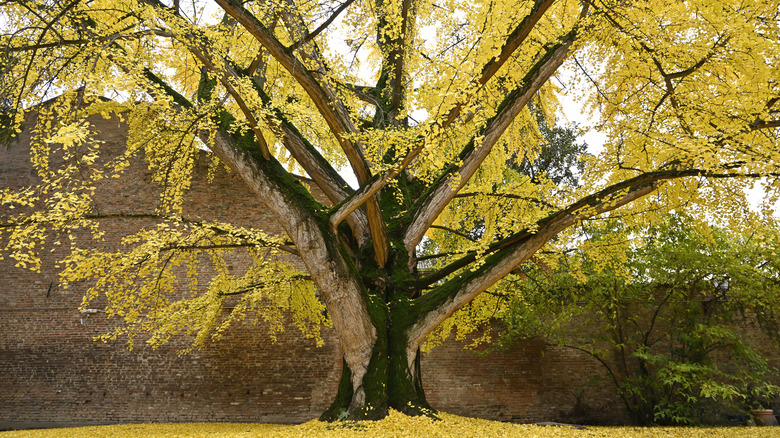The Perfect Shade Tree For Your Yard Was Around When Dinosaurs Roamed The Earth
On hot days, it helps to have a cool spot in the yard where you can come out and relax under. When you aren't looking to renovate your outdoor space and don't have the money to build a whole gazebo, then you can settle on planting a tree that can give you shade. Shade trees have wide canopies and thick foliage to keep the sun from beating down on you mercilessly. They also provide you with clean air and are calming to look at. If you're absolutely obsessed with trees that have interesting backstories like we are, then your ideal shade tree would be the Ginkgo biloba. Revered as sacred in many parts of Asia, this tree comes with a lot of mind-blowing stats, but the most fascinating of them all is that it stands as the longest-living fossil and predates even the dinosaurs.
When discussing antiquated plants, you have to give ginkgo its props. The living relic clocks in at over 200 million years old, which makes it older than humanity itself. Nicknamed the "maidenhair tree," it can grow to an impressive 100-foot height and 8-foot diameter, making it one of the most perfect natural yard shades money could buy.
Benefits of growing Ginkgo biloba
One would think that having a living fossil in your yard is prize enough, but there are even more reasons to love your ginkgo tree. As mentioned, the China native is a great investment if you're looking for shade from the sun. Its dense canopy is made up of fan-shaped leaves, which is where its special name, "biloba" comes from: it's Latin and means "two lobes." Ginkgo is also known for its beauty, especially in the fall when the leaves turn yellow.
Ginkgo trees are slow growers, so you will have to factor in how long it would take for them to be able to block out the sun. The good news is that this is a tree that will grow super tall. If 100 feet sounds intimidating, you can also opt for a shorter variety that will average 20 to 50 feet –– this will keep the size manageable and might keep the Homeowner's Association off your back.
Ginkgo biloba is also known for its nuts, which taste great when cooked. However, this comes at a cost. The fruit is produced by the female trees, which are notoriously smelly. The stench comes from the seed pod and is often likened to expired butter. Hence, most people prefer to plant the male trees instead. The leaves are used in many ancient remedies and are typically made into teas. However, consult with your doctor before incorporating it into your diet.
Things to consider with Ginkgo biloba
Before you go ringing up that ginkgo tree purchase, there are some things you have to know about growing the living fossil. Ginkgo trees are pretty hardy and even survived the Hiroshima atomic bomb. Regardless, just like any other tree, they require water and sunlight. Ginkgo biloba is also a drought-resistant plant. However, these trees prefer a humid environment over drier regions, so if you live in an arid zone, a ginkgo tree is probably not the shade tree for you.
Ginkgo biloba loves well-drained soil and only really needs constant attention during its youthful state. This translates to adequate sunlight at least four hours a day, adequate watering, and routine fertilizer treatments. Once the tree matures, it gets pretty comfortable, and you won't have to do much around it. Considering the fact that they live very long, the oldest ginkgo being about 3,500 to 4,500 years old, you can rest assured that they can handle themselves quite well.


